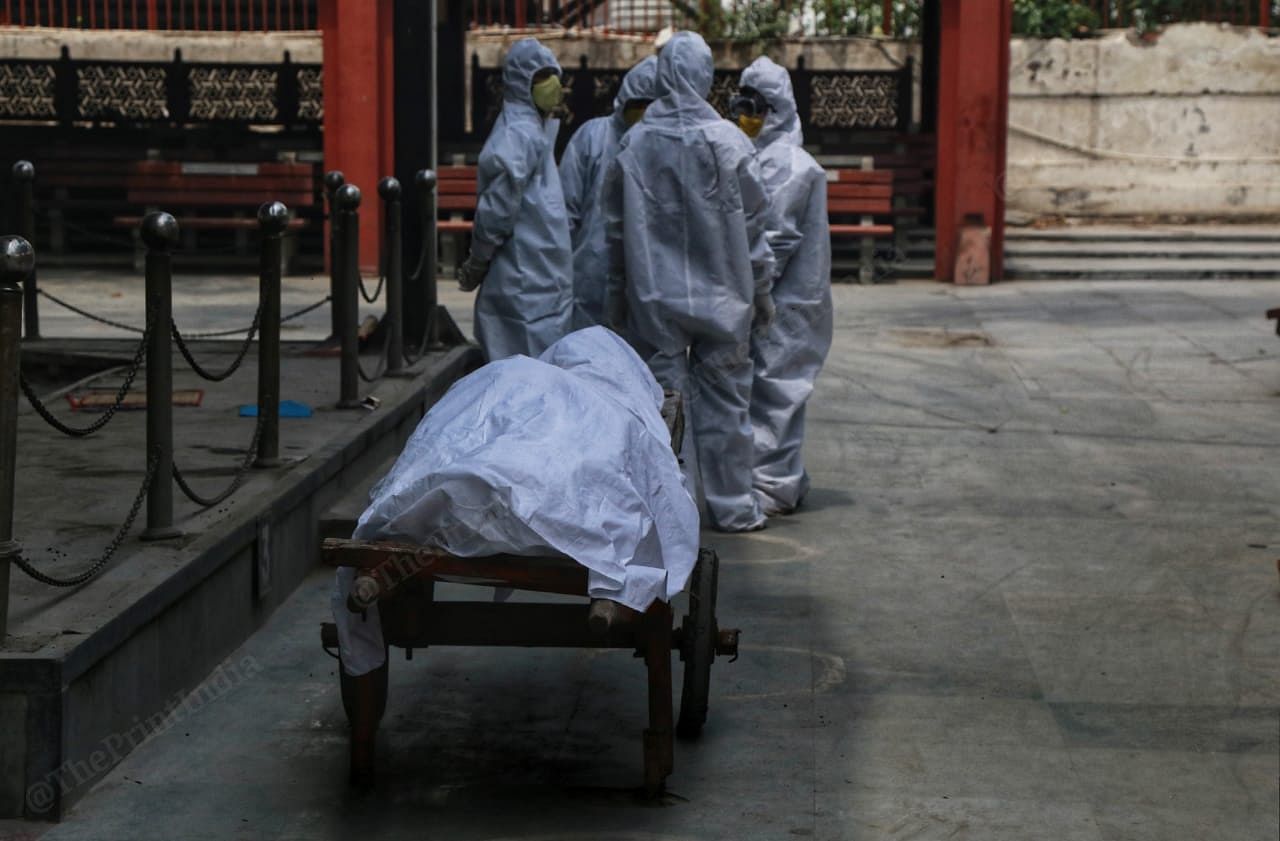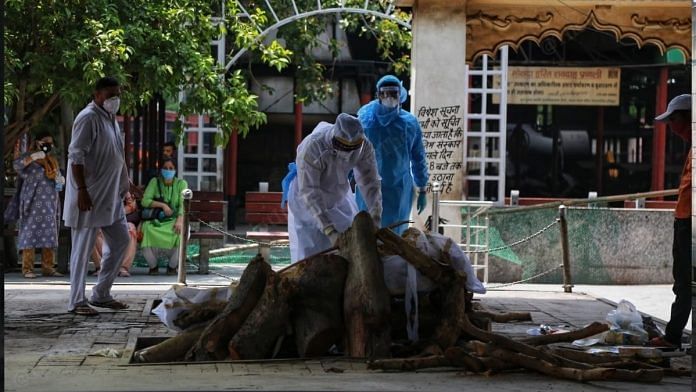New Delhi: The Arvind Kejriwal government reported 584 fewer Covid-19 deaths compared to the consolidated figures submitted by the national capital’s north, south and east municipal corporations until Friday, data from Delhi’s municipal corporations shows.
Three Delhi municipal corporations recorded 4,155 Covid deaths until 17 July, according to data accessed by ThePrint. However, the Delhi government pegged this figure at 3,571 in its 17 July health bulletin.
As of 10 July, the North Delhi Municipal Corporation (NDMC) had reported 1,364 Covid deaths, the South Delhi Municipal Corporation (SDMC) at 2,160, followed by the East Delhi Municipal Corporation (EDMC) with 346 deaths, data shows. Between 10 and 17 July, NDMC recorded 97 deaths, SDMC 159 and EDMC 29 — a total of 285 deaths.
However, a senior Delhi government official said on condition of anonymity, “While the figures till July 10 are of confirmed Covid deaths and were submitted as is to the Delhi health department, the ones from 11 to 17 July could change slightly since records of each death is yet to be verified.”
Both suspected and confirmed Covid cases are cremated or buried at Covid crematoriums and burial grounds, in line with the World Health Organization’s Covid guidelines.
The Delhi government has said in the past that data gets updated a day later in the health bulletin. However, even the 11 July bulletin recorded 3,334 Covid deaths — short by 536 at that point.
As of Saturday, Delhi has reported 1,20,107 cases and 3,571 deaths.
This comes barely two months after Delhi made headlines for discrepancies in its Covid death toll.
A senior official of the Delhi government’s health department said, “The data gets adjusted in subsequent days at times, as at times the deaths recorded till a particular date do not reflect in the bulletin on that day or the subsequent day due to the verification process.”
However, this doesn’t mean that the government was underreporting deaths, said the official, who didn’t wish to be identified.
ThePrint reached Delhi Health Minister Satyender Jain and Director General, Health Services, Nutan Mundeja via calls and texts for a comment but there was no response till the time of publishing this report.
Also read: Kerala sees increase in Covid positivity rate, Delhi’s tests per million climbs
How data is arrived at
For calculating Covid deaths in Delhi, crematoriums under the three municipal corporations submit data for both suspected and confirmed deaths to the district health inspectors concerned. The chief medical officers in each zone verify this data against hospital records to arrive at the final figure.
This is then submitted to the government, which reports the tally in its daily Covid bulletins.
“Since many suspected cases of death, which may have been due to a heart attack or any other comorbidity, is categorised as Covid death due to symptoms, medical officers and doctors go over the data to categorise what are confirmed Covid deaths,” said a medical officer on condition of anonymity.
According to the data accessed by ThePrint, the Punjabi Bagh crematorium under SDMC, and Nigambodh Ghat cremation under NDMC recorded the maximum tally of 1,548 and 903 deaths, respectively, until 10 July.

Seemapuri cremation ground, which has seen the highest number of deaths under EDMC, reported 156 deaths. The Lodhi Road ground, an electric crematorium, recorded 221 deaths while the burial ground, cremation ground, and cemetery in Mangol Puri cumulatively recorded 167 deaths.
Discrepancies under scanner since May
This isn’t the first time that discrepancies in Covid deaths have emerged in Delhi. In May, ThePrint reported how the national capital registered four times the government death figures.
Even hospitals were earlier held responsible for not submitting details of the total number of deaths in time to the death audit committee of the Delhi government. Hospitals were also directed to ensure “timely reporting of deaths of Covid positive persons” in accordance with the standard operating procedures.
Jai Prakash, standing committee chairperson, NDMC, said, “This is not the first time this is happening, and the Delhi government now does not have any excuse if the data does not even include suspected cases.”
On 22 May, Delhi Health Minister Satyender Jain had said no death caused due to Covid was missed in the count. “Deaths of suspected cases are not included in the Covid-19 death count,” he had said.
Also read: Govt plans Rs 7,000 cr urban health scheme, will use RWAs to handle Covid shock to cities
Situation on ground improves
The ground situation at crematoriums, however, seems to be improving as the Covid curve has eased in the national capital over the last few days.
On Tuesday, the Nigambodh Ghat barely resembled the crematorium it was just a couple of weeks ago. There were no queues, no waiting time and no bodies piled on top of each other in hearse vans.
“We have been getting maximum 12 bodies a day for both CNG and wooden (pyre) cremations for the past 10 days,” said Avdesh Sharma, in-charge, Nigambodh Ghat, Delhi’s largest crematorium. On an earlier visit in June, ThePrint had found that the ghat was conducting an average of 40 funerals a day.

Hearse vans, carrying a minimum of two and maximum of six dead bodies each until just last month, are now bringing in only one. “The trend has changed in the last 10 days. The number of deaths has come down and we are only getting bodies from eight hospitals as opposed to 22 earlier,” said Sharma.
Ansar, a hearse van driver for LNJP Hospital who was on his third round to the ghat Tuesday morning, said the load has decreased significantly.
“I have brought three bodies in three rounds today. Even a week ago, by this time I would bring at least 6-7 bodies. There would be a long waiting time that would often stretch to 5-6 hours but now it’s all done almost immediately so we can make multiple trips,” he said.
The other crematorium handling the most Covid deaths is Punjabi Bagh. Here, a total of 1,785 bodies had been cremated until 10 July, including suspected cases as well. However, the confirmed number is at 1,548.
However, with the drop in deaths, Punjabi Bagh, which conducts both wooden pyre and CNG cremations, too is managing better.
“Earlier, we would get an average of 40 bodies a day but now in the last two weeks, we get a maximum of 10-12 and sometimes even 4 or 5 bodies a day,” said K.S. Chanana, in-charge Punjabi Bagh crematorium.
With inputs from Sravasti Dasgupta.
Also read: Study identifies gene variations that increase susceptibility to Covid-19




Any idea of the total deaths (all causes) during all months in 2019 (also 2018) and in 2020 thus far? Can The Print get the data and tell us.
It will clear all speculation and repose faith in the Nation (or otherwise)